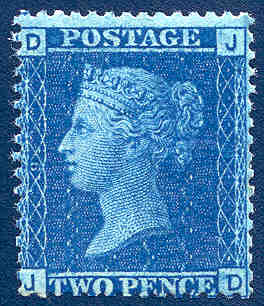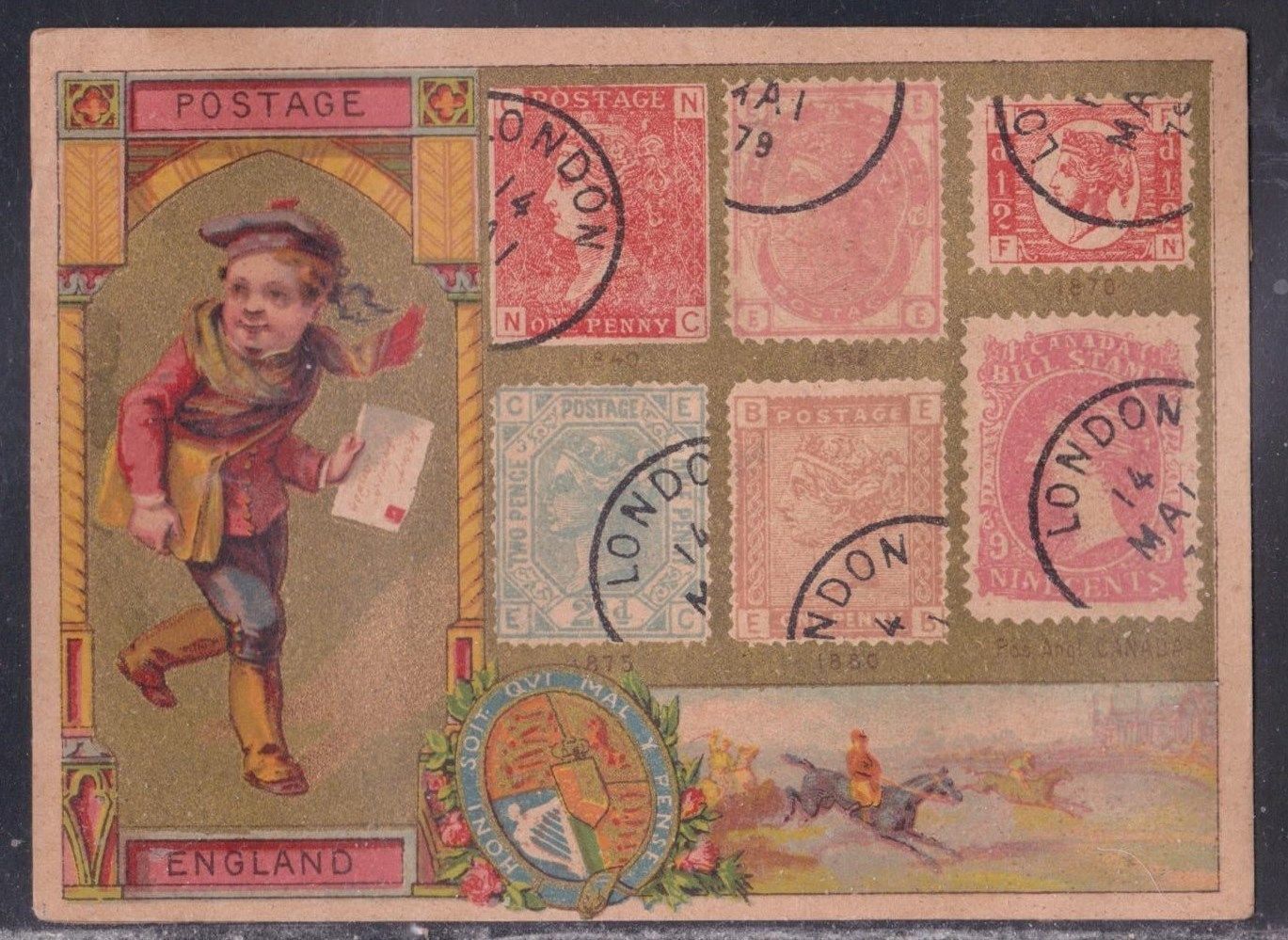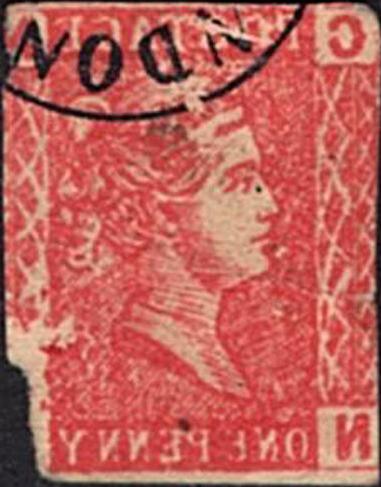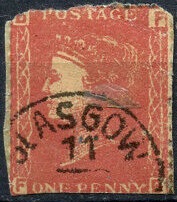 |
|||||
|
|||||
| Preview of Stamps Catalogue: VOLUME 1 |
 |
|||||
|
|||||
| Preview of Stamps Catalogue: VOLUME 1 |
Return To Catalogue - Great Britain Overview Great Britain Penny Black forgeries, part 1 - Great Britain Penny Black forgeries, part 2
Note: on my website many of the
pictures can not be seen! They are of course present in the catalogue;
contact me if you want to purchase it.
1 p black (Penny Black) 2 p blue

(Non issued official stamp, 'VR' in the upper corners)
The 1 p is called 'Penny Black' it is the first stamp ever issued in the world. A 1 p black with the letters 'VR' in the upper corners was prepared as official stamp, but was never issued. These stamps have watermark 'Small Crown':
There are letters printed in the lower corners of the stamp, according to their position on a sheet of stamps, thereby creating 240 different stamps. Thus the first upper left stamp has the letters 'AA', the next one 'AB' until 'AL' for the most upper right stamp. The second row has 'BA', 'BB', BC' to 'BL'. The bottom row has 'TA' at the left up to 'TL' for the bottom right hand corner stamp.
Value of the stamps |
|||
vc = very common c = common * = not so common ** = uncommon |
*** = very uncommon R = rare RR = very rare RRR = extremely rare |
||
| Value | Unused | Used | Remarks |
| 1 p | RRR | R | |
| 2 p | RRR | RR | |
| 1 p VR in upper corners | RRR | Not issued | |
Note: even though a lot of stamps were printed, these stamps are still very wanted, since everybody wants to posess the first stamp of the world....

Rainbow trial in lilac, front and backside, reduced size
Some essays exist with the upper right corner not printed and the corner letters omitted in several colours; they are the so-called 'rainbow trials'. Literature: Rainbow Trials by David Rowse.

Essay with the portrait of Prince Albert instead of Queen
Victoria. Apparently this essay was made by Henry Archer. I've
also seen this essay in red color (with the same corner letters
'FJ').


(forgery of the 2 p stamp, using the next issue and colouring the
white lines blue,
zoom-out of top and bottom part)
1 p brown 2 p blue (design changed slightly)
Black ink was used for the cancels of the 1 p black, but it was not satisfactory because inadequate cancels could not easily be detected. The ink for the cancellation was then changed to red, but could be readily removed with a solvent. Therefore, the stamp became red with a more fugitive ink, and the cancellation became black, hence the reason for this 1 p brown (red) stamp.
The 2 p now has two white lines below 'POSTAGE' and above'TWO PENCE'; shortly after the issue of the 2d stamp of 1840, it was noticed that the dark blue obscured the black cancel, therefore the stamp was lightened by placing the white lines.
The watermark on these stamps is 'Small Crown'. These stamps exist with a so-called 'ivory-head' the head is shining through on the back side of the stamp:
Value of the stamps |
|||
vc = very common c = common * = not so common ** = uncommon |
*** = very uncommon R = rare RR = very rare RRR = extremely rare |
||
| Value | Unused | Used | Remarks |
| 1 p | RR | * | |
| 2 p | RR | *** | |
1 Penny brown (red) 2 Pence blue
The watermark is 'Small Crown' or 'Large Crown' for this issue. Two different perforations exist: 14 and 16 (exist both with both watermarks).
Value of the stamps |
|||
vc = very common c = common * = not so common ** = uncommon |
*** = very uncommon R = rare RR = very rare RRR = extremely rare |
||
| Value | Unused | Used | Remarks |
Watermark 'Small Crown', perforated 16 |
|||
| 1 p | RR | * | |
| 2 p | RRR | *** | |
| Watermark 'Small Crown', perforated 14 | |||
| 1 p | RR | R | |
| 2 p | RRR | R | |
| Watermark 'Large Crown', perforated 16 | |||
| 1 p | RRR | R | |
| 2 p | RRR | RR | |
| Watermark 'Large Crown', perforated 14 | |||
| 1 p | ** | c | |
| 2 p | RRR | *** | |

Some kind of very primitive reproduction of the 1 p red stamp.



1 Penny brown 2 Pence blue
The watermark of this issue is 'Large Crown' (see picture above) and the perforation is 14. These stamps have plate numbers (although often very difficult to see due to cancels), the pictures below shows a stamp with plate number 225, it is hidden inside the left and right borders, the yellow arrows show the positions of the 2, 2 and 5 in the second image:

![]()

Plate '225'; see arrows in second image and plate '184' (zoom-in
of the right hand side of the stamp)
The plate numbers on the 1 p range from 71 to 225. Some platenumbers are rare, such as '77' and '225'. The plate numbers on the 2 p range from 7 to 15.
Value of the stamps |
|||
vc = very common c = common * = not so common ** = uncommon |
*** = very uncommon R = rare RR = very rare RRR = extremely rare |
||
| Value | Unused | Used | Remarks |
| 1 p | ** | c | |
| 2 p | R | c | |
The postoffice discovered that members of the public were pasting together parts of uncancelled stamps. In order to prevent that, it was decided that for the stamps above, the corner letters would also be printed on top of the stamps (matching with the bottom stamps in reverse order). As a further security measure, the plate numbers were introduced.

Card with images of stamps. On the back an advertisement in
French for 'Fleur de Froment' (flower for use in the kitchen) in
Orleans (France).

Also an 'inverted' forgery based on the above design?

German card with images of stamps "Die Post in
England".

Cut from the above German card with 'GLASGOW 11" cancel..
The first Maltese cancels were done in red, but later black was also quite common. More uncommon colours as blue, violet, yellow, brown and orange also exist. Several types of these cancels exist.

Maltese cross with number '3'
In London, some of these Maltese cancels exist with a numeral in the center (used from March 1843 to April 1844).
More on the Cancels of Great Britain can be found by clicking here.
http://www.members.tripod.com/~pennyreds/yz.html
Great Britain Line Engraved Victoria Made Easy by Wm F Blank: http://www.kernunnos.com/Philately/GBQVLE.html, explanation of all the types of these stamps (recommended!).